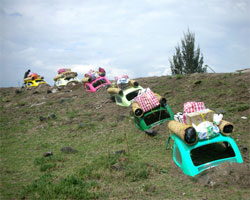A Review: Bestabeé Romero: Lágrimas Negras (Black Tears)

Today’s post is by guest blogger Joseph House. Joseph is an Art History and American studies major at Manhattanville College. He is currently a Junior, but has always had a passion for contemporary art. He frequently visits galleries and museums and thinks one can never spend too much time in an art museum.
Black Tears is a ten-year survey of one of Mexico’s most celebrated artists, Betsabeé Romero. Ms. Romero considers herself a “Mechanic Artist,” and draws from pre-Columbian iconography, colonial imagery and pop culture. She ingeniously refashions cars, tires, and various other mediums to explore a Mexican society dominated by speed and mass production. The artists states, “The car is by far the object that attracts the greatest aesthetic attention among people of all ages and social classes.” Her current show at the Neuberger Museum of Art at SUNY Purchase is an incredible display of old and new works. She completely utilized the space to create an explosion of culture. Everywhere one looks they are surrounded by bright colors, floral patterns and speed. Romero’s use of untraditional materials, such as chewing gum is astounding. Her mastery of unconventional materials and the depiction of Mexican culture is what makes the exhibition successful.
When one enters the gallery they are greeted by a huge installation called Light Anemone, 2008. The artist took large pieces of paper, cut them up in semi-floral designs, drew patterns in pencil and allowed them to hang freely in the gallery. The use of light and shadow is emphasized because of the white-walled gallery. The gallery is flushed with red and silver light, which gives one the feeling of a Mexican festival at twilight. The shadows on the wall, however, are painted exactly how they would exist in real life. The paint contributes to the artist’s artistic vision, and also allows the viewer to see how talented she is in different mediums.
Light Anemone is accompanied by an exciting piece called Ciudades Que Se Van (Moving Cities) 2004. The artist again completely involves the viewer. It is a huge piece consisting of carved tires soaked in ink then rolled down a large piece of cloth. The symbols carved into the tire allude to the ancient cultures of Mexico, but at the same time stay completely modern. The cloth is similar to the clothing that is hung throughout Mexico City. It is as if one is walking through the underdeveloped side of Mexico City on laundry day. It is a mesmerizing piece that again shows the cultural sophistication of the artist.
The second gallery shows the artist’s ability to work in photography and sculpture. The eye is drawn to a huge colorful pinwheel suspended on the wall. Cinnamon Pinwheel, 2000, is a large pinwheel made completely out of front fenders from a Volkswagen Beetle. The curvature of the fender and use of bright colors attributes to the movement and energy that is felt throughout the exhibition.
The rest of the gallery is draped with very large photographs of cars in a Mexican setting. One picture is of a car adorned with floral patterns and filled with roses, but stuck in the sand at the Mexican/American Border. The car, and what’s beyond the border is a symbol of freedom that the Mexican people cannot attain because they are stuck in the sand. The next photograph depicts five men pushing the car out of the sand, which harps on the resilience of the Mexican people.
The interest in patterning, color and culture exists in almost every piece in the exhibition. This creates movement, excitement and alludes to the Mexican culture. One gets a real sense of the artist’s personal connection with the art, which is something that should be commended. The artist has pumped every inch of her psyche and soul into her works, which seeps through each photograph, sculpture and installation, and creates a truly powerful experience. The use of tires and involvement of the audience can in some ways be compared to Allan Kaprow’s famous work, Yard, 1961, but is completely her own. She has come up with a style that is fresh, exciting and something that should be appreciated and seen by the art community. Romero turned two plain white cubes in a first-class museum into a fast-paced and exciting display of Mexican Culture.


Connect with Janet